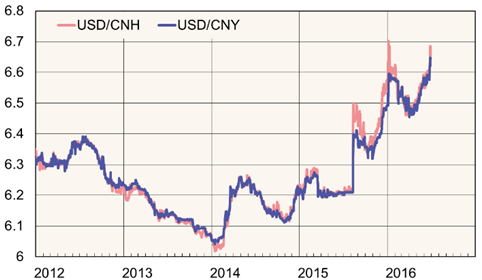BOFIT Weekly Review 26/2016
Yuan weakens against the dollar
The PBoC has allowed the yuan to depreciate fairly swiftly over the past three months. The yuan has lost 3 % of its value against the dollar since end-March, and currently is plying levels not seen since 2010. On Monday (June 27), with the dust from the UK Brexit referendum beginning to settle, the PBoC set its daily average dollar fixing rate about 1 % weaker than its Friday posting. On Thursday (June 30), the market exchange rate in mainland China (onshore yuan or CNY) was 1 % weaker than a week ago and one dollar bought 6.64 yuan. Some market participants believe that the central bank intervened in the forex markets over the past week to stabilise the yuan’s exchange rate. The movements of the Hong Kong offshore exchange rate (CNH) this week have been slightly larger, but the CNH rate is also down about 1 % from last week.
The underlying causes of the yuan’s depreciation are the strong dollar and the PBoC’s gradual shift to the use of a multi-currency basket to track the yuan’s external valuation. Following the announcement of the Brexit result, the central bank said that it planned to keep the yuan’s exchange rate “basically stable.” While exchange rate stability is a fairly loose term, it is clear that yuan exchange rate flexibility will increase with the opening up of China’s financial markets to the world. Increased exchange rate volatility in this case is a positive signal that China is progressing towards a floating yuan. The trend also increases China’s need to enhance communication of its exchange rate policy.
Yuan-dollar onshore and offshore exchange rates: CNY (Shanghai) and CNH (Hong Kong)

Source: Macrobond